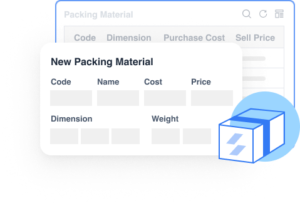 Picking and packing is the process of collecting products for a Sales Order and preparing them for shipment. Picking generally refers to picking up the goods that need to be shipped out according to the shipping order. While it may seem straightforward to place the products in a box, maintaining an organized structure and closely monitoring each step of the process is crucial to avoid errors. In a fast-paced environment where multiple operators are responsible for fulfilling orders, it’s essential to take proactive measures to prevent potential issues such as mis-picks, missed picks or damage.
Picking and packing is the process of collecting products for a Sales Order and preparing them for shipment. Picking generally refers to picking up the goods that need to be shipped out according to the shipping order. While it may seem straightforward to place the products in a box, maintaining an organized structure and closely monitoring each step of the process is crucial to avoid errors. In a fast-paced environment where multiple operators are responsible for fulfilling orders, it’s essential to take proactive measures to prevent potential issues such as mis-picks, missed picks or damage.
The first step of the process, known as “pick,” involves choosing the products from the warehouse or inventory to meet the order’s requirements. This task is typically carried out by a warehouse worker or an automated system that uses barcode scanning technology to identify the necessary products.
Once the products have been picked, the next step is “pack,” which involves packaging the chosen items for shipment, including preparing the shipping label.
Preparations
When your e-commerce sales channel is connected to your order fulfillment system, any incoming Sales Order will be automatically routed to the designated warehouse. You have the option to configure the software to create a digital or physical picking/packing slip for the warehouse personnel, which may include barcodes to aid in locating the correct items in the appropriate location.
Movements and extraction
Once the operator has reviewed the picking/packing slip and located the products, they must extract the exact SKUs from the warehouse. As there could be several variations of the same product, this step requires careful attention to ensure that the correct items are selected on the first attempt. The worker will return the products to the operations desk or shipping station.
Verification
Before being packed and shipped, the products must undergo an inspection process to confirm that they match the picking/packing slip and are free from any damage or defects. This crucial step is necessary to guarantee the satisfaction of your customers.
The next step involves placing the items in appropriate packaging and preparing them for shipment. The operator must first choose the proper packing materials that match the products’ size, weight, and level of fragility. In some cases, orders may require multiple layers of packaging, particularly when grouping products into bundles.
 Following this, the package should be inspected to ensure compliance with the shipping carrier’s regulations. This step typically involves creating a custom dispatch label with information such as the parcel reference number, tracking number, recipient name, and address. Companies may also include details such as the contents’ SKU, sizing, weight information, barcodes, and more.
Following this, the package should be inspected to ensure compliance with the shipping carrier’s regulations. This step typically involves creating a custom dispatch label with information such as the parcel reference number, tracking number, recipient name, and address. Companies may also include details such as the contents’ SKU, sizing, weight information, barcodes, and more.

Speed and efficiency:
Batch order picking can reduce operating time since employees can fulfill multiple orders in one trip. Moreover, ShipOut’s barcode pick and pack system automatically directs team members to the most efficient route between SKUs, increasing their productivity on the warehouse floor.
Improved accuracy:
Another significant advantage of the pick-and-pack process is its accuracy. With real-time inventory updates and a two-step scanning process, the likelihood of errors is minimized, resulting in enhanced customer satisfaction and fewer returns for your sales team to handle.
Useful insights:
Lastly, ShipOut’s batch shipping system provides real-time inventory data accessible from any workstation or mobile device. This feature allows you to access accurate inventory information up to the minute, enabling you to make informed business decisions even while on the go.
Choose the right picking strategy:
Selecting a picking strategy that is tailored to your warehouse’s unique challenges is crucial. Choosing an overly advanced method may yield limited efficiency gains, while a basic solution may impede business growth. Consider implementing straightforward inventory software to enhance your strategy without complicating your workflow.
Optimize warehouse layout:
When organizing your warehouse, prioritize minimizing travel time. Utilize your sales data to identify the most popular products and position them closer to the picking area entrance. Moreover, aim to reduce the number of touches required to handle products. This will not only increase picking efficiency but also reduce the risk of damaged stock.
Identify strengths and weaknesses:
Occasionally, a single flaw in the system can impede the entire operation. To identify critical improvement areas, analyze your current picking and packing processes. Conduct a comprehensive review of each process stage, including picking face labels, ordering sheets, and location selection. Additionally, assess what’s working well to maintain those areas of the process.
Increase operational visibility:
An integrated warehouse management system (WMS) lets you conveniently access your inventory data across all your warehouse and retail locations. To maximize the benefits of your system, ensure that you properly synchronize your WMS with any necessary third-party integrations, such as enterprise resource planning (ERP) or accounting software.

Last updated: 2025-04-01

Last updated: 2025-03-03

Last updated: 2025-02-05

Last updated: 2025-01-02